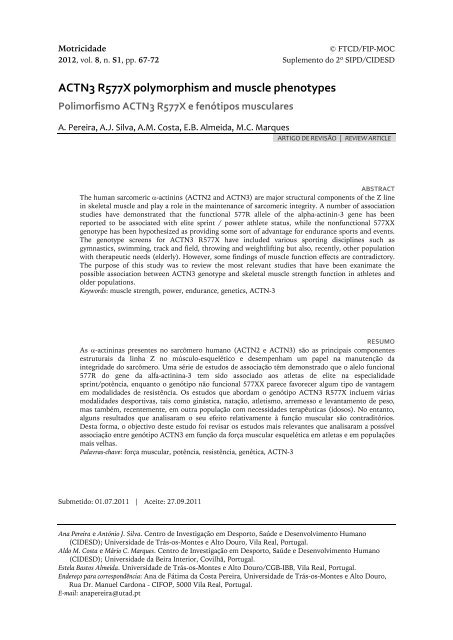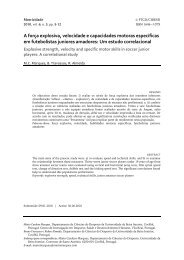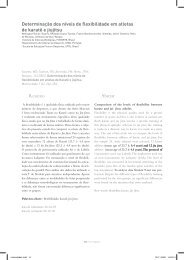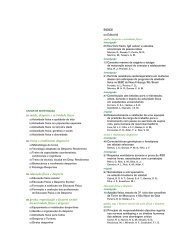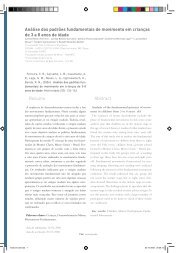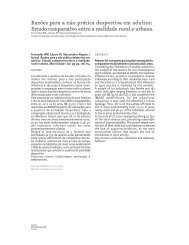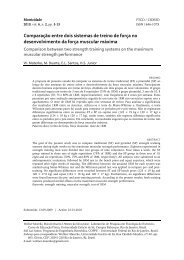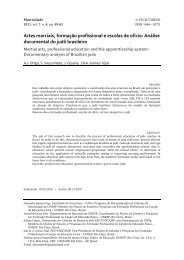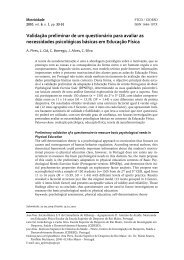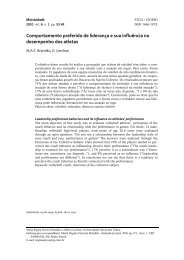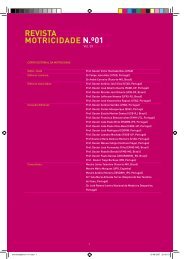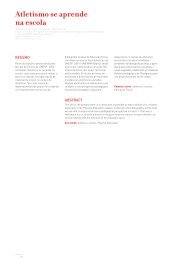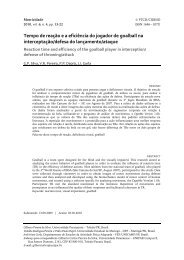revista motricidade
revista motricidade
revista motricidade
- No tags were found...
Create successful ePaper yourself
Turn your PDF publications into a flip-book with our unique Google optimized e-Paper software.
Motricidade<br />
© FTCD/FIP-MOC<br />
2012, vol. 8, n. S1, pp. 67-72 Suplemento do 2º SIPD/CIDESD<br />
ACTN3 R577X polymorphism and muscle phenotypes<br />
Polimorfismo ACTN3 R577X e fenótipos musculares<br />
A. Pereira, A.J. Silva, A.M. Costa, E.B. Almeida, M.C. Marques<br />
ARTIGO DE REVISÃO | REVIEW ARTICLE<br />
ABSTRACT<br />
The human sarcomeric α-actinins (ACTN2 and ACTN3) are major structural components of the Z line<br />
in skeletal muscle and play a role in the maintenance of sarcomeric integrity. A number of association<br />
studies have demonstrated that the functional 577R allele of the alpha-actinin-3 gene has been<br />
reported to be associated with elite sprint / power athlete status, while the nonfunctional 577XX<br />
genotype has been hypothesized as providing some sort of advantage for endurance sports and events.<br />
The genotype screens for ACTN3 R577X have included various sporting disciplines such as<br />
gymnastics, swimming, track and field, throwing and weightlifting but also, recently, other population<br />
with therapeutic needs (elderly). However, some findings of muscle function effects are contradictory.<br />
The purpose of this study was to review the most relevant studies that have been exanimate the<br />
possible association between ACTN3 genotype and skeletal muscle strength function in athletes and<br />
older populations.<br />
Keywords: muscle strength, power, endurance, genetics, ACTN-3<br />
RESUMO<br />
As α-actininas presentes no sarcômero humano (ACTN2 e ACTN3) são as principais componentes<br />
estruturais da linha Z no músculo-esquelético e desempenham um papel na manutenção da<br />
integridade do sarcômero. Uma série de estudos de associação têm demonstrado que o alelo funcional<br />
577R do gene da alfa-actinina-3 tem sido associado aos atletas de elite na especialidade<br />
sprint/potência, enquanto o genótipo não funcional 577XX parece favorecer algum tipo de vantagem<br />
em modalidades de resistência. Os estudos que abordam o genótipo ACTN3 R577X incluem várias<br />
modalidades desportivas, tais como ginástica, natação, atletismo, arremesso e levantamento de peso,<br />
mas também, recentemente, em outra população com necessidades terapêuticas (idosos). No entanto,<br />
alguns resultados que analisaram o seu efeito relativamente à função muscular são contraditórios.<br />
Desta forma, o objectivo deste estudo foi revisar os estudos mais relevantes que analisaram a possível<br />
associação entre genótipo ACTN3 em função da força muscular esquelética em atletas e em populações<br />
mais velhas.<br />
Palavras-chave: força muscular, potência, resistência, genética, ACTN-3<br />
Submetido: 01.07.2011 | Aceite: 27.09.2011<br />
Ana Pereira e António J. Silva. Centro de Investigação em Desporto, Saúde e Desenvolvimento Humano<br />
(CIDESD); Universidade de Trás-os-Montes e Alto Douro, Vila Real, Portugal.<br />
Aldo M. Costa e Mário C. Marques. Centro de Investigação em Desporto, Saúde e Desenvolvimento Humano<br />
(CIDESD); Universidade da Beira Interior, Covilhã, Portugal.<br />
Estela Bastos Almeida. Universidade de Trás-os-Montes e Alto Douro/CGB-IBB, Vila Real, Portugal.<br />
Endereço para correspondência: Ana de Fátima da Costa Pereira, Universidade de Trás-os-Montes e Alto Douro,<br />
Rua Dr. Manuel Cardona - CIFOP, 5000 Vila Real, Portugal.<br />
E-mail: anapereira@utad.pt


